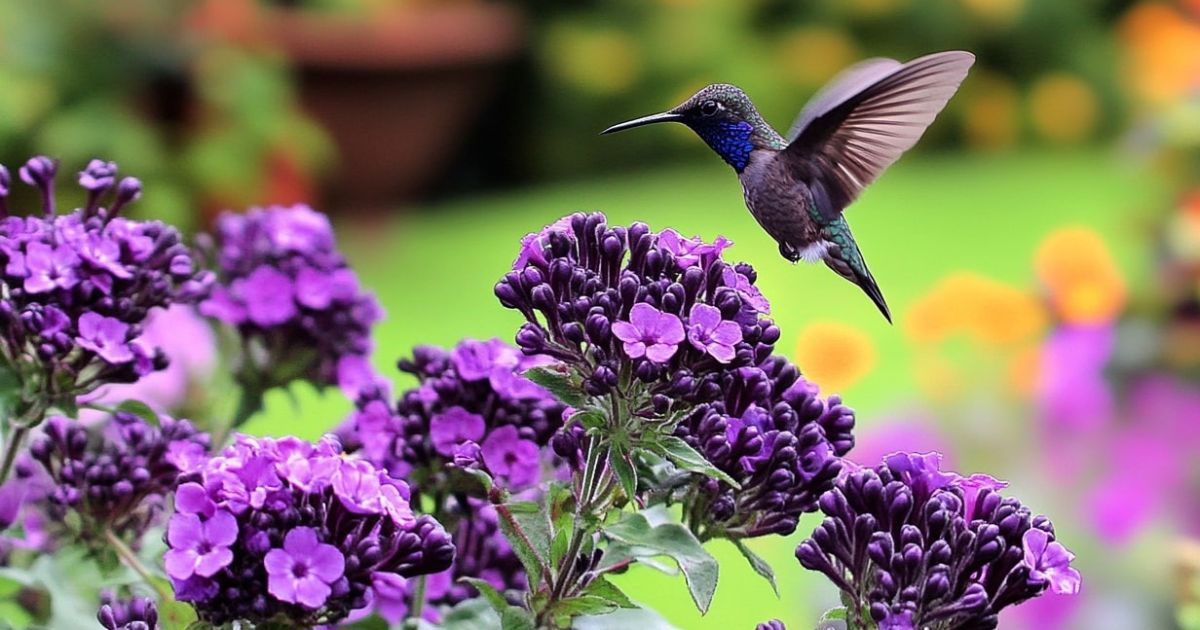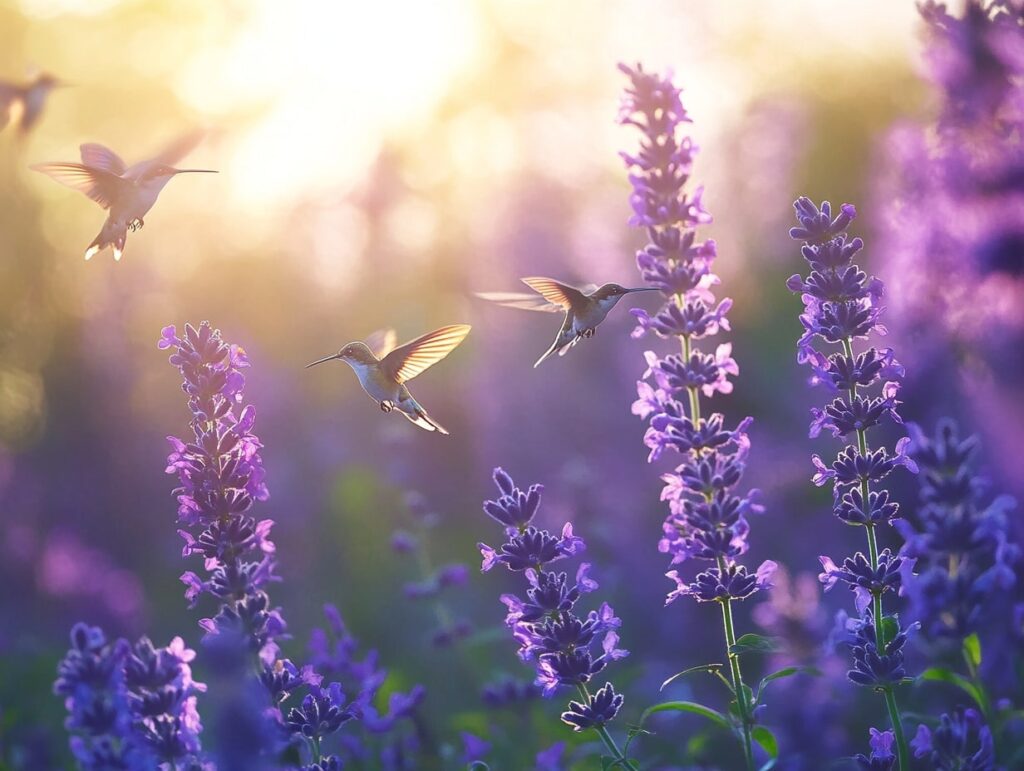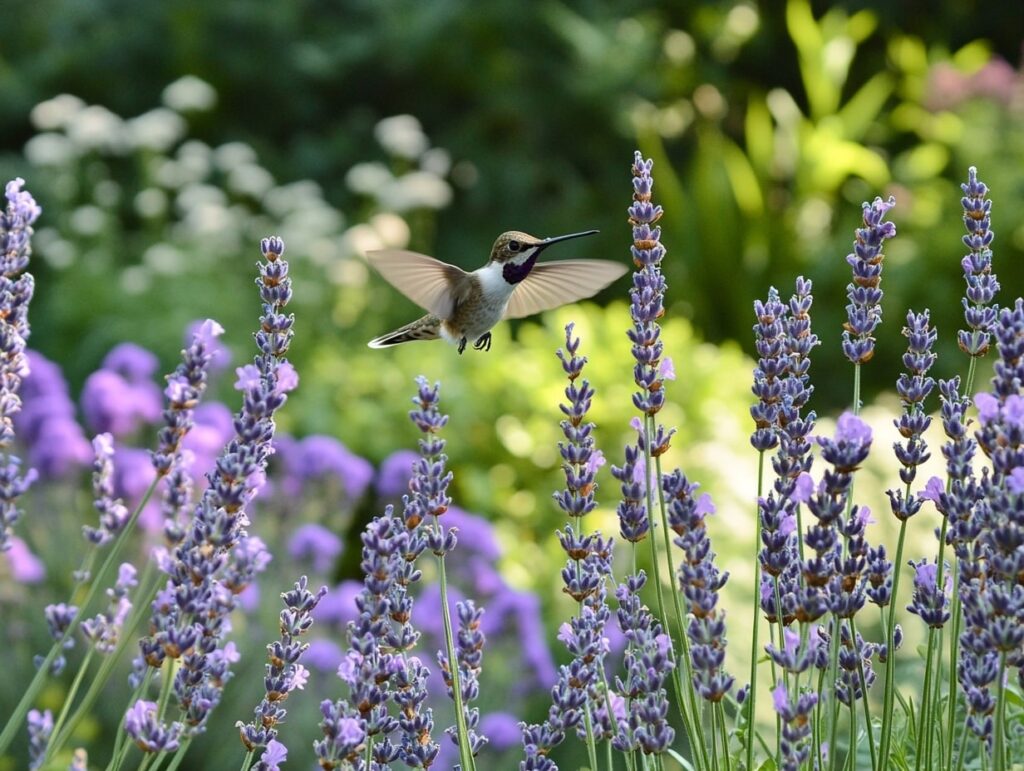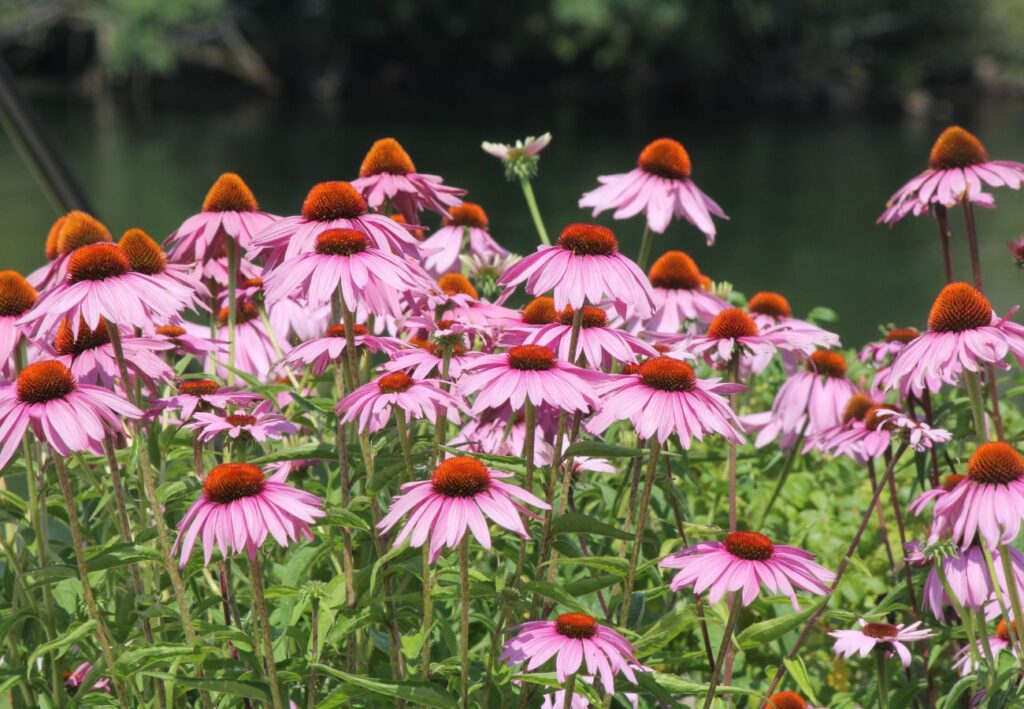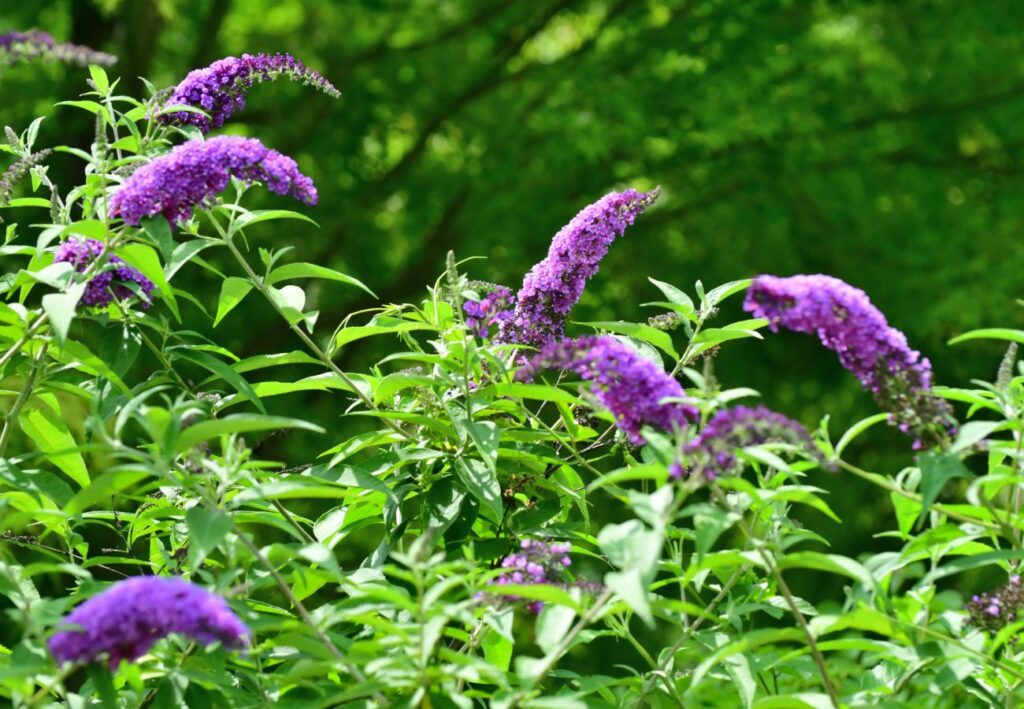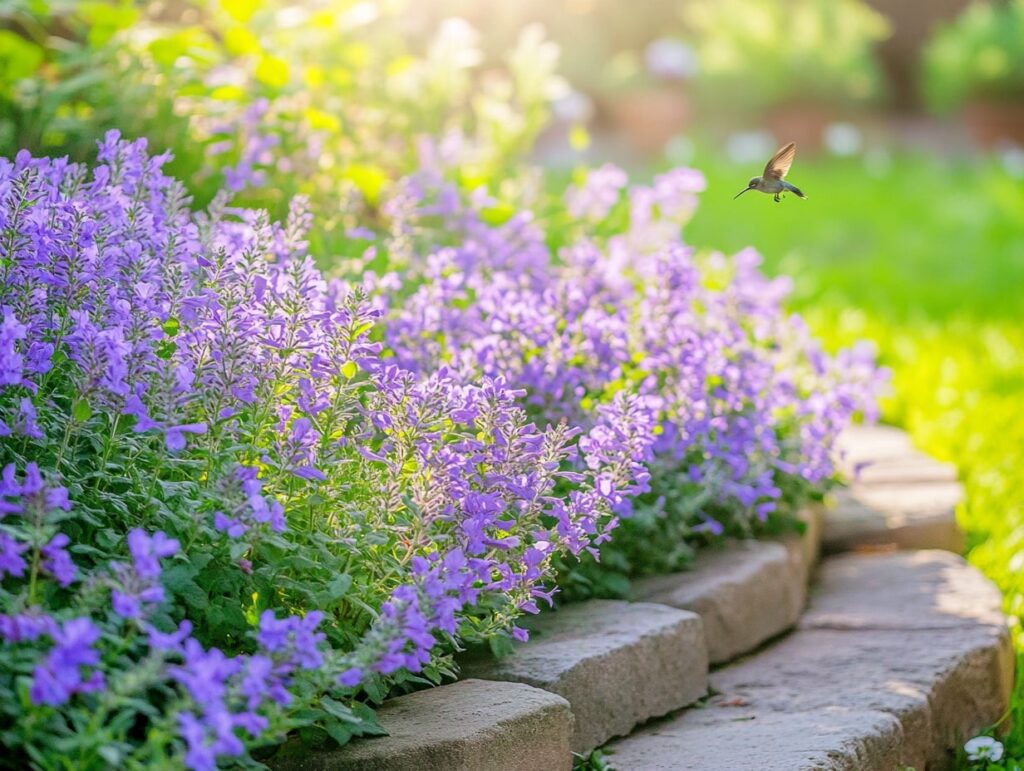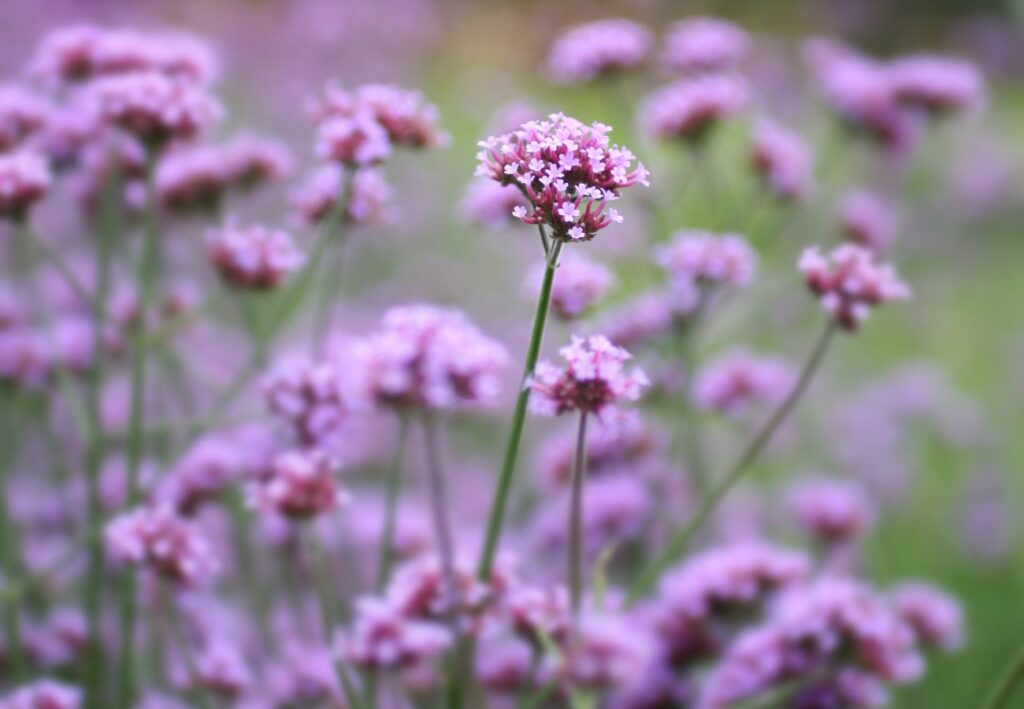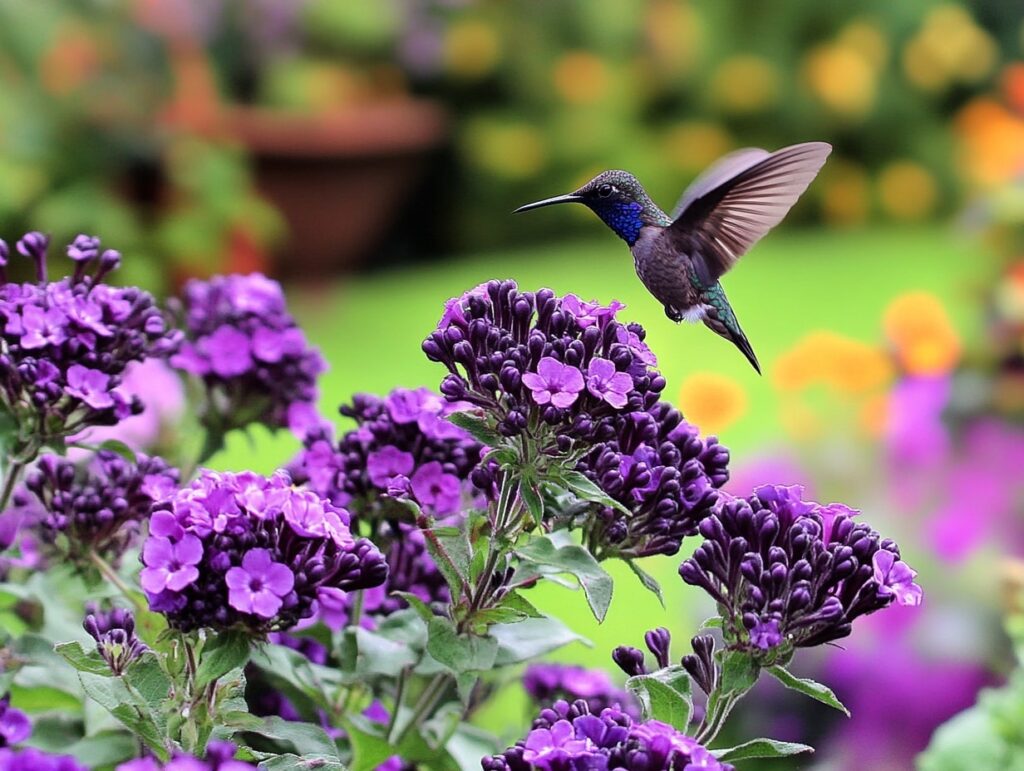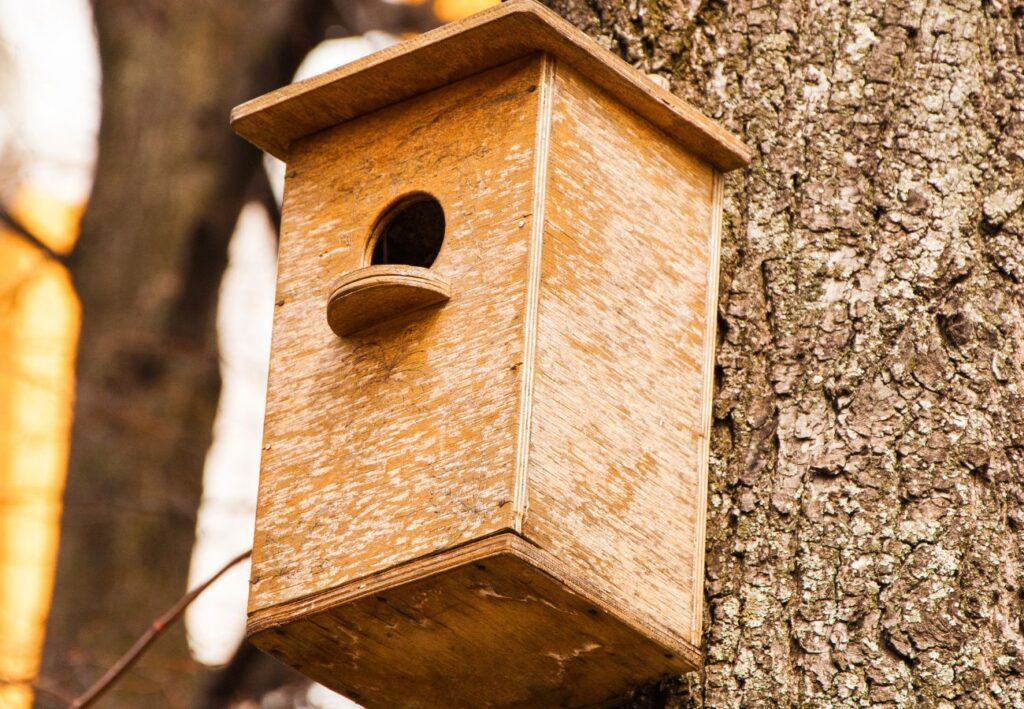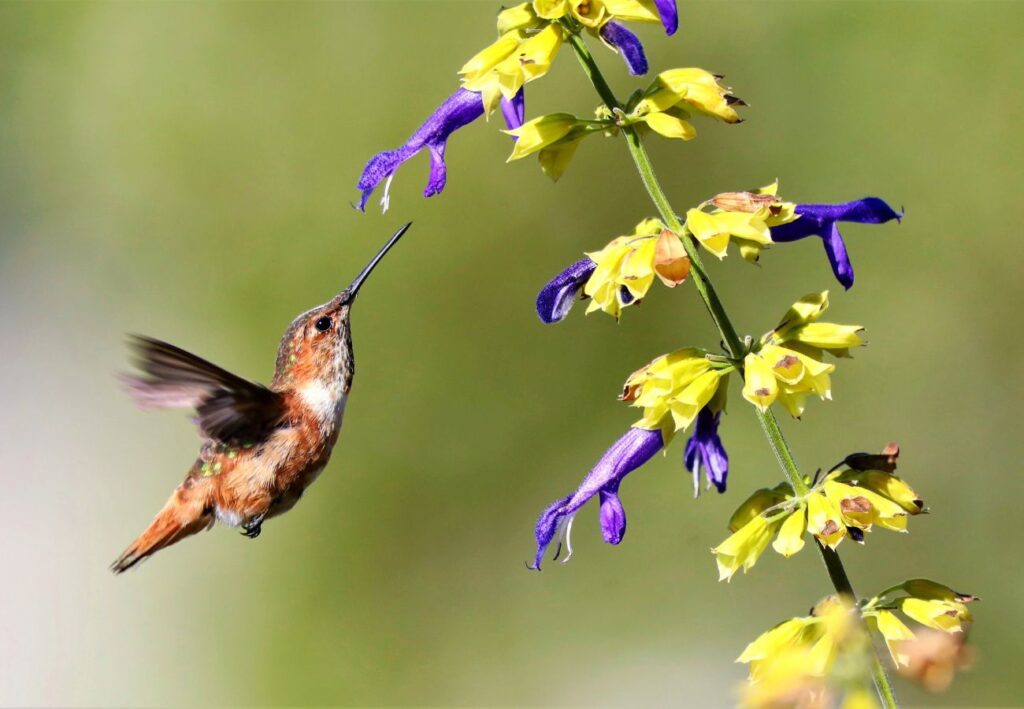Transform your garden into a hummingbird haven with these beautiful purple flowers. Including purple blooms such as lavender, salvia, and clematis can attract these enchanting birds to your outdoor space.
These flowers not only add a pop of color but also provide the nectar that hummingbirds love and need for energy.
Once you introduce these vibrant flowers into your garden, you’ll likely find yourself enjoying the sight of hummingbirds flitting about more frequently. A thoughtfully planted garden with their favorite purple flowers can make all the difference.
Whether you’re a seasoned gardener or just starting, adding these 11 gorgeous purple flowers can set the stage for a hummingbird paradise. Take a moment to explore the possibilities and see how easy it can be to invite these delightful creatures into your world.
Understanding Hummingbirds’ Attraction to Purple Flowers
Hummingbirds are naturally drawn to bright colors, and purple flowers often catch their eye. The vibrant hues signal rich nectar sources, which these energetic birds need to fuel their high metabolism.
Colour Perception
Hummingbirds see colors on the ultraviolet spectrum, making purple appear even more vivid to them. This enhanced vision helps them locate food sources more efficiently.
Nectar Abundance
Purple flowers often produce ample nectar. By planting varieties rich in nectar, you will create a buzzing hub that attracts hummingbirds looking for their next meal.
To attract hummingbirds, place these plants in sunny areas, as hummingbirds are active during the day. Keep your garden refreshed with water to maintain nectar production.
Plant Placement
Space the plants to provide enough room for hummingbirds to hover and feed comfortably. Creating a layered garden with flowers at varying heights can make it easier for hummingbirds to find flowers.
You can also mix in other brightly colored flowers, but keep the focus on purple to create a consistent and attractive environment for hummingbirds.
1. Lavender (Lavandula)
Lavender is a classic garden favorite known for its fragrant blooms and soothing color. This perennial shrub produces spikes of purple flowers that are a magnet for hummingbirds.
Lavender thrives in well-drained soil and full sun, making it an easy addition to most gardens. Besides attracting hummingbirds, lavender also brings in bees and butterflies, enriching your garden’s ecosystem.
Tips for Growing Lavender:
- Plant in an area with plenty of sunlight.
- Ensure the soil is well-drained; lavender does not like wet roots.
- Prune after flowering to maintain shape and encourage new growth.
2. Salvia (Salvia spp.)
Salvia, commonly known as sage, is a must-have in any hummingbird-friendly garden. With varieties that bloom in various shades of purple, salvia provides continuous color throughout the growing season.
These tubular flowers are especially appealing to hummingbirds, who find their shape perfect for feeding.
Tips for Growing Salvia:
- Plant in full sun to partial shade.
- Water regularly but allow the soil to dry out between waterings.
- Deadhead spent flowers to encourage more blooms.
3. Russian Sage (Perovskia atriplicifolia)
Russian sage is a drought-tolerant perennial that produces long, airy spikes of lavender-blue flowers. Its delicate appearance belies its toughness, as it can thrive in poor soils and hot, dry conditions.
Hummingbirds are drawn to the abundant nectar in its flowers, making it an excellent choice for a low-maintenance garden.
Tips for Growing Russian Sage:
- Choose a sunny spot with well-drained soil.
- Water sparingly once established, as Russian sage is drought-resistant.
- Cut back old growth in early spring to promote new growth.
4. Purple Coneflower (Echinacea purpurea)
The purple coneflower is a native North American plant that has long been a favorite among gardeners and pollinators alike. Its large, daisy-like flowers with prominent central cones are a visual treat, and hummingbirds love to visit them for their rich nectar.
Tips for Growing Purple Coneflower:
- Plant in full sun to partial shade.
- Echinacea is adaptable to various soil types but prefers well-drained soil.
- Deadhead spent blooms to extend the flowering period.
5. Butterfly Bush (Buddleja davidii)
The butterfly bush is renowned for attracting butterflies, but its fragrant clusters of purple flowers are also highly appealing to hummingbirds.
This fast-growing shrub can reach considerable heights, providing a focal point in your garden and a reliable nectar source throughout the summer.
Tips for Growing Butterfly Bush:
- Plant in full sun for best flower production.
- Prune back heavily in early spring to encourage new growth and more flowers.
- Be aware that some varieties can be invasive, so choose non-invasive cultivars if necessary.
6. Catmint (Nepeta spp.)
Catmint is a hardy perennial that produces spikes of purple-blue flowers from late spring to early fall. Its aromatic foliage and abundant flowers make it a favorite for both hummingbirds and gardeners looking for a low-maintenance plant.
Tips for Growing Catmint:
- Plant in full sun to partial shade.
- Catmint thrives in well-drained soil and is drought-tolerant once established.
- Cut back after the first bloom to encourage a second flowering.
7. Verbena (Verbena spp.)
Verbena is a long-blooming annual or perennial that produces clusters of small, vibrant purple flowers. It’s an excellent ground cover or filler plant in borders and containers, and its continuous blooms provide a reliable food source for hummingbirds.
Tips for Growing Verbena:
- Plant in full sun for the best flowering.
- Water regularly but do not allow the soil to become waterlogged.
- Pinch back tips to promote bushier growth and more flowers.
8. Bee Balm (Monarda didyma)
Bee balm, also known as Monarda, is a striking perennial with spiky purple flowers that are a favorite of hummingbirds. Its aromatic foliage and vibrant blooms add a splash of color and a lovely fragrance to your garden.
Tips for Growing Bee Balm:
- Plant in full sun to partial shade.
- Bee balm prefers moist, well-drained soil.
- Divide clumps every few years to keep the plants vigorous and prevent overcrowding.
9. Clematis (Clematis spp.)
Clematis is a versatile climbing plant that can be trained over trellises, fences, or arbors. With a wide range of purple varieties, clematis offers large, showy flowers that are irresistible to hummingbirds. Its ability to climb makes it ideal for adding vertical interest to your garden.
Tips for Growing Clematis:
- Plant in a spot where the roots are shaded but the tops receive full sun.
- Provide a sturdy support structure for climbing.
- Prune according to the variety you grow, as different types of clematis require different pruning methods.
10. Heliotrope (Heliotropium arborescens)
Heliotrope is a fragrant annual or perennial that produces clusters of deep purple flowers. Its sweet scent and rich color make it a wonderful addition to any hummingbird garden, particularly in containers or borders where its fragrance can be enjoyed up close.
Tips for Growing Heliotrope:
- Plant in full sun to partial shade.
- Heliotrope prefers rich, well-drained soil.
- Water regularly to keep the soil consistently moist but not soggy.
11. Petunia (Petunia spp.)
Petunias are a popular annual with a wide range of colors, including many stunning shades of purple.
Their trumpet-shaped flowers are ideal for hummingbirds, providing easy access to the nectar they love. Petunias are versatile and can be planted in beds, borders, or containers.
Tips for Growing Petunias:
- Plant in full sun for the most prolific blooms.
- Water regularly, especially in containers, but avoid overwatering.
- Deadhead spent flowers to keep the plants looking tidy and encourage continuous blooming.
Creating a Hummingbird Paradise: Additional Tips
Beyond planting these gorgeous purple flowers, there are several additional steps you can take to ensure your garden is a true paradise for hummingbirds.
Provide Fresh Water: Hummingbirds need water not only for drinking but also for bathing. Consider adding a shallow birdbath with a fountain or mister, as hummingbirds are particularly attracted to moving water.
Avoid Pesticides: Pesticides can harm hummingbirds and the insects they feed on. Opt for organic gardening methods to create a safe and healthy environment for all wildlife in your garden.
Offer Supplemental Feeding
In addition to natural nectar from flowers, you can offer hummingbirds a homemade nectar solution in a feeder. Mix four parts water with one part white granulated sugar, and clean the feeder regularly to prevent mold and fermentation.
Create Shelter: Hummingbirds need places to rest and hide from predators. Plant trees and shrubs that provide shelter and nesting sites, and consider adding a few hummingbird nesting boxes to your garden.
Plan for Continuous Blooming: To keep hummingbirds coming back throughout the season, plan your garden so that there are always flowers in bloom. Choose a mix of early, mid, and late-blooming plants to ensure a consistent supply of nectar.
By incorporating these 11 gorgeous purple flowers into your garden, along with following the tips provided, you can create a hummingbird paradise that will draw these delightful creatures to your yard year after year.
Not only will your garden be filled with the vibrant hues of purple blossoms, but it will also become a lively and dynamic space buzzing with the activity of hummingbirds, butterflies, and other pollinators.
Whether you’re an experienced gardener or just starting, these plants and ideas will help you create a truly enchanting outdoor haven.
